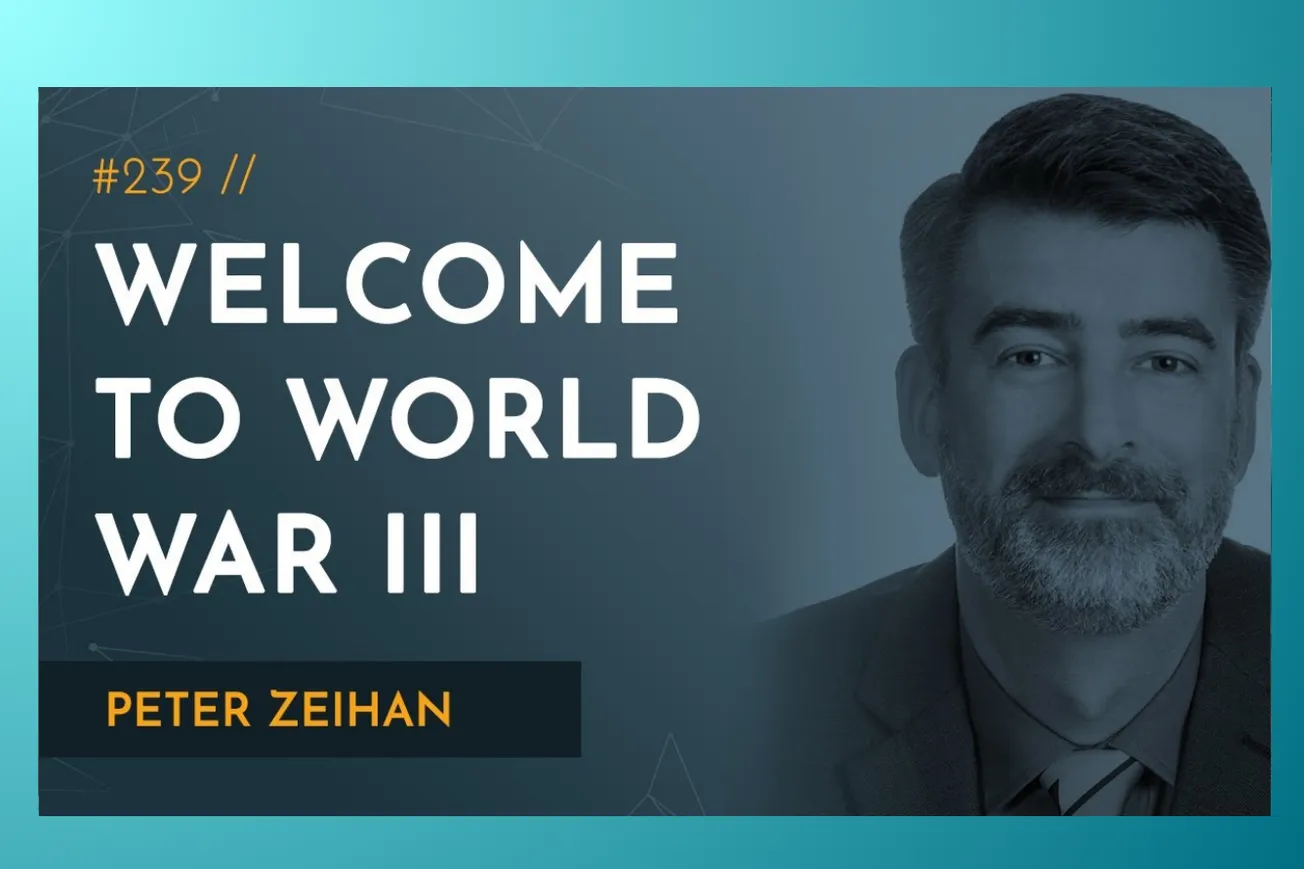Table of Contents
Geopolitical strategist Peter Zeihan explains why Ukraine represents Russia's demographic last stand and how this conflict reshapes global power dynamics.
Key Takeaways
- Russia's invasion stems from demographic collapse - this is their last chance before losing military capacity
- Putin's plan extends beyond Ukraine to five NATO countries to secure all nine historical invasion gateways
- Russian military performance reveals catastrophic incompetence, potentially ending their status as a near-peer power
- Energy and food crises will trigger multi-year global depression and continental famines regardless of war outcome
- China faces strategic disaster as sanctions demonstrate the fragility of their economic model
- The conflict accelerates dollar dominance rather than undermining it, eliminating alternative currency systems
- Germany's rearmament and Turkey's rising power create new strategic dynamics reminiscent of historical patterns
- Nuclear escalation risks center on direct NATO-Russia confrontation, not cyber or economic warfare
- Biden's information warfare success and coalition building contrasts sharply with Obama and Trump approaches
Timeline Overview
- 00:00–08:15 — Introduction and Geopolitical Context: Setting up the conversation about Ukraine within the broader framework of American withdrawal from globalization and the multipolar disorder
- 08:15–15:30 — Russia's Historical Imperative and Gateway Strategy: Why Russia's geography and invasion history drive the need to control nine strategic gateways, and how losing Soviet territory left them vulnerable
- 15:30–22:45 — Invasion Performance Analysis: Comparing expectations versus reality of Russian military competence, logistical failures, and the impact on US strategic assessments
- 22:45–30:20 — Why Ukraine Matters Globally: Russian information warfare against the US, nuclear threats, and why Ukraine is the perfect battlefield to bleed Russia without core American interests at stake
- 30:20–38:45 — Putin's Larger Strategic Plan: The original goal to take Moldova and five NATO countries (Estonia, Latvia, Lithuania, eastern Poland, and parts of Romania) to plug all gateways
- 38:45–46:10 — Demographic Catastrophe and Military Leadership Crisis: How successive demographic disasters from WWI through Soviet collapse created terminal population decline and depleted military expertise
- 46:10–53:20 — American Leadership Evolution: Comparing Bush Sr.'s successful post-Cold War management with subsequent presidents' retreat from global leadership
- 53:20–01:00:35 — Nuclear Escalation Pathways: When and how nuclear threats become credible, including energy blackmail scenarios targeting Germany and Turkey
- 01:00:35–01:08:50 — Energy Crisis Implications: Oil prices heading to $170-200, natural gas shortages, potential US export bans, and European industrial collapse scenarios
- 01:08:50–01:16:25 — China's Strategic Miscalculations: How the Ukraine war destroyed 50 years of Chinese planning, Xi's isolation problems, and Taiwan invasion implications
- 01:16:25–01:23:40 — Middle East Realignment: Saudi Arabia's pivot toward China, American strategic withdrawal, and the collapse of traditional Gulf security arrangements
- 01:23:40–01:30:15 — Dollar System Strengthening: Why sanctions prove dollar dominance rather than undermining it, and the absence of viable alternatives
- 01:30:15–01:37:30 — American Domestic Political Impact: How successful Ukraine policy could reshape Biden's presidency and Republican party dynamics around foreign policy
Russia's Demographic Doomsday and the Last War
Peter Zeihan's most chilling insight centers on Russia's terminal demographic crisis driving the timing of this invasion. "The Russian birth rate has been declining for decades. And when you have things like famines or world war, you have a lot of people who are killed. The birth rate in those years is significantly lower." Russia has experienced successive demographic catastrophes: World War I, World War II, collectivization, Brezhnev-era stagnation, and the post-Soviet collapse of the 1990s.
The people born during the post-Soviet collapse are now becoming the draftable population, creating what Zeihan calls "the second worst demography on the planet, second only to China." This demographic cliff means Russia is "literally running out of soldiers. If they didn't do this attack now, if they waited five years, it would be too late. They wouldn't have the army to try."
This demographic disaster extends beyond just troop numbers to military leadership and technical expertise. "That has melon scooped not just out their troops, but also their skilled labor and their leadership potential. And that includes their military leadership." The catastrophic military performance in Ukraine - from 40-mile convoys running out of fuel to troops abandoning equipment after two days without food - may reflect a hollowed-out officer corps lacking basic competence.
The strategic implication is profound: this represents Russia's last conventional military adventure. Win or lose in Ukraine, they lack the demographic foundation for future large-scale military operations. This creates desperate urgency in Russian planning and willingness to accept massive casualties that would deter other nations.
The Nine Gateways: Putin's True Strategic Objectives
Zeihan's geographic analysis reveals Putin's objectives extend far beyond Ukraine to a comprehensive campaign to secure all nine historical invasion routes into Russia. "The Russian goal, going back to Catherine the Great, has always been the same. Expand beyond those flats until you can control the gateways that give access to the Russian space."
When the Soviet Union controlled all nine gateways, Russia enjoyed unprecedented security. Post-Soviet Russia controls only one gateway, creating existential vulnerability from their perspective. Ukraine provides access to several gateways, but the strategic plan requires additional territories: "Two of the remaining gaps are on the other side of Ukraine, specifically the Polish-Lithuanian gaps that, in the past, the Germans or the Turks have used to invade."
The full campaign requires taking five NATO countries: "Estonia, Latvia, and Lithuania are one of those gateways on the Baltic Coast, that's how the Swedes have invaded in the past. Eastern Poland, going up to the Vistula River in Downtown Warsaw to plug the Polish gap, which is how the Germans have always liked to invade and then going to the Southwest a little bit to grab territory adjacent to Moldovan Ukraine that is in Romania to plug the best Arabian gap."
This analysis transforms the conflict from a regional dispute to a direct challenge to NATO's core members. Moldova serves as an intermediate step, vulnerable through existing Russian forces in Transnistria. The strategic logic demands these moves follow Ukrainian pacification, making the current conflict a preview of larger confrontations ahead.
Military Competence Collapse and Strategic Implications
The Russian military's performance has shocked even experienced analysts. Zeihan describes failures that go beyond tactical mistakes to fundamental incompetence: "Only giving your troops two days' of food to occupy a city of three million. No, that's not enough. For a convoy 40 miles long to not have fuel trucks. I'm sorry, that's horrible planning."
More concerning, these failures repeat mistakes from previous conflicts: "We know they learned in Grozny. If you've got a tightly packed convoy, that means all the other guy has to do is hit the first vehicle and hit the last vehicle. And then they just dice up everything in between. That's happened dozens of times. The Russians have lost all the hard lessons that they've paid for with blood in previous conflicts."
The implications for US strategy are profound. "We now know that if an American force comes up against a Russian force, the Russian force is going to be obliterated." This capability gap eliminates Russian conventional deterrence while paradoxically increasing nuclear risks: "For the Russians, this is an issue of absolute national security for them. If American forces of any type become involved in that kind of conflict, the Russians will have two choices. A humiliating strategic withdrawal that they may never recover from or escalate to nukes."
This dynamic shapes the Western approach: "Feed as many weapons systems as we can into the Ukrainian space. Anything that does not require a fixed point support. So no planes, no fixed air defense assets, but lots of missiles, lots of vehicles, and keep the Russians locked down on Ukraine as long as possible." The goal becomes bleeding Russian capacity in Ukraine to prevent future adventures rather than direct confrontation.
The China Miscalculation and Strategic Isolation
China's response to the Ukraine invasion reveals fundamental strategic miscalculations driven by Xi Jinping's extreme isolation. "Chairman Xi has isolated himself, or executed, or exiled, or imprisoned anyone in China with an independent thought." This isolation created an intelligence failure where "Putin lied to his face about what was going to go down in Ukraine" during their pre-Olympics meeting.
The war's outcome has "obliterated 50 years of strategic planning on China's part." Chinese leaders initially expected easy Russian victory and minimal sanctions, viewing it as a test case for Taiwan. Instead, they discovered that comprehensive Western sanctions would be catastrophic for China: "While Russia is an energy exporter, it's self-sufficient in energy and food... China's self-sufficient in neither. They import 80% of their energy and they import 80% of the inputs that is necessary for them to grow food in the first place."
The corporate boycotts particularly shocked Beijing: "Every Western company just pulling out, abandoning anything they had done as a sunk cost, just writing it off completely. Because again, that is what the Chinese have assumed, that no one can get by without them. And now that they know that is not true, they've got to start over."
Xi's institutional isolation prevents adaptive responses: "China's now institutionally incapable of even absorbing the information, much less make a decision on it." This creates policy paralysis exactly when strategic flexibility is most needed, potentially locking China into supporting Russia despite changing circumstances.
Energy Warfare and the German Question
The energy dimension of the conflict creates opportunities for Russian strategic leverage despite military failures. Zeihan identifies a potential pathway for fracturing NATO through energy blackmail: "Very soon, Putin will be able to go to the German government and the Turkish government, and say, 'Look, we can keep the lights on for you, only for you, but it comes at the price of you pulling out of the NATO coalition against us as regard to the Ukraine war.'"
The energy arithmetic is stark: "We're talking about five million barrels a day of crude going away. And we're talking about 10 BCF of natural gas going away. That means the lights go out in Europe, industry shuts down, and some of these countries will just flat out deindustrialize." Germany faces particularly acute vulnerability given their energy dependence and previous pipeline commitments.
However, Germany's response has surprised even Zeihan: "On the third day of the Ukraine war, Chancellor Schultz, who is a pacifist and a socialist announced that within two years, the Germans were going to double their defense spending." This rearmament creates historical echoes that concern strategic observers: "As a student of history, I had to take a step back there for a second, because it felt really familiar and not at all comfortable."
The energy crisis extends beyond European politics to global economic impacts. Zeihan projects oil prices "never drop below 150 again" and potentially reaching $200 during active conflict. Natural gas shortages will force European industrial shutdowns and potential permanent deindustrialization of energy-intensive sectors.
Nuclear Escalation: Scenarios and Guardrails
Nuclear escalation risks focus on specific scenarios rather than general threats. Zeihan identifies the primary pathway: "The single biggest one is the one I mentioned earlier, that we have a direct confrontation between NATO forces and Russian forces and the Russian forces are just destroyed." The conventional military gap creates a paradox where Russian weakness increases nuclear danger.
Russian nuclear threats over weapons shipments appear empty: "We saw absolutely no increase in preparation of their nuclear forces after Putin gave that order." However, escalation becomes credible in specific contexts: "Once they're on the border of NATO from Estonia down to Romania, and they go for a grand push, and they use the threat of nukes to get what they want."
The energy leverage scenario provides an alternative escalation pathway. If Russia successfully splits NATO through energy blackmail, "there is no NATO position versus the Russians if Turkey and Germany are not a part of the coalition. And if, at that point, you've pulled those two countries out, then all of a sudden that nuclear threat really rings well because there is no way, conventionally, you could defend these places anyway."
The fundamental risk factor is Russian desperation driven by demographic reality: "We're talking about a country that sees this as their last chance for survival. They will make decisions now that they would've never made during the Soviet period." This creates willingness to accept risks that rational actors would avoid.
The Dollar's Unintended Strengthening
Contrary to predictions that sanctions would undermine the dollar system, Zeihan argues the opposite has occurred: "What these sanctions are proving is that there's only going to be one currency, and it's going to be the U.S. Dollar. There are no alternatives." The comprehensive sanctions, including freezing Russian central bank reserves, demonstrate both the dollar's reach and the absence of viable alternatives.
Alternative currency systems face fundamental problems. Chinese yuan manipulation makes it unsuitable: "If the Yuan replaces the global dollar, the Chinese will be intervening in currency markets every second of every day to ensure maximum economic penetration for their goods." Other currencies lack necessary liquidity or stability for global trade settlement.
The sanctions reveal the dollar's underlying strength: "Countries are slowly and begrudgingly coming to the realization that if you want stability in your trade, that means that the country in charge, the United States, is going to demand certain things from time to time." Even cryptocurrency fails as an alternative: "The second the sanctions were announced, every access point between Bitcoin and the real financial sector got locked up."
This dollar consolidation accelerates American financial dominance rather than creating multipolar monetary systems. Countries must choose between dollar system participation with its rules and constraints or isolation from global financial flows.
Middle East Realignment and the Saudi Pivot
The Ukraine conflict accelerates American strategic withdrawal from the Middle East, forcing regional realignment. "Total troops in the Middle East are now in the triple digits, most of which is special forces in the Syrian conflict." This withdrawal eliminates the strategic foundation of the US-Saudi relationship built around energy security guarantees.
Saudi Arabia faces limited options in this new environment: "You have gone from the American system underwriting you and guaranteeing your independence to the Americans, just not really overly caring all that much." The pivot toward China represents necessity rather than preference: "From the Saudi point of view, the Chinese don't have enough energy demand and they are not beholden to the Persian Gulf."
The fundamental problem is Chinese inability to provide security guarantees: "China, as an end consumer cannot secure the supply routes that the Saudis would need to get their product to their end consumer." This creates an unstable arrangement where energy flows depend on routes China cannot protect.
The broader regional implications include potential nuclear proliferation as traditional security guarantees erode: "The Swedes, the Pols, the Romanians, they're going to have to decide whether a nuclear option is something they have to have. They all have the technology to do it."
American Political Transformation
The Ukraine crisis provides an opportunity for American political realignment after years of foreign policy retreat. Zeihan traces the decline from George H.W. Bush's successful Cold War conclusion: "He set us on the path to getting rid of 80% of the nuclear weapons on the planet. Those are a couple huge wins, from my point of view."
Subsequent presidents retreated from global leadership: "In the next eight elections, seven elections, we voted in the candidate who wanted to do less with the world." This created the vacuum that enabled current crises: "If we had stuck with George Herbert Walker Bush 25 years ago... The Russians would probably not be a threat. China would be a radically, radically different place."
Biden's response represents a potential inflection point: "The biggest surprise that Putin has had, is that the United States actually has stood up, for the first time, in over a decade." Success in Ukraine could enable broader strategic renewal: "If Biden is successful in locking the Russians down or war that destroys them in Ukraine, the American population is going to love that."
However, the outcome depends on managing multiple simultaneous crises: "We've got a food crisis, we've got an energy crisis. We're going to have a German and Turkish crisis. Based on how that all rolls out... a lot does pivot on how the decisions that are made vis-a-vis Kiev right now."
Conclusion
Peter Zeihan's analysis reveals the Ukraine conflict as a pivotal moment in global strategic realignment. Russia's demographic catastrophe has forced a desperate gamble that, regardless of immediate outcomes, represents their final conventional military adventure. The poor performance of Russian forces eliminates their near-peer status while paradoxically increasing nuclear risks through desperation.
The conflict accelerates trends already reshaping the global order: American strategic withdrawal, Chinese isolation and miscalculation, European rearmament, Middle Eastern realignment, and dollar system consolidation. Energy and food crises will create global economic disruption lasting years beyond any military resolution.
Most significantly, the war demonstrates the fragility of assumptions underlying the post-Cold War order. Neither globalization nor nuclear deterrence provides the stability once assumed. Instead, geography, demographics, and resource control reassert themselves as primary drivers of international relations.
The ultimate lesson may be that historical patterns reassert themselves despite technological change. Russia's geographic vulnerability drives expansion regardless of political system. China's isolation recreates imperial decision-making pathologies. Germany's economic power generates military potential that concerns neighbors. These deeper forces operate beneath the surface of daily political events, shaping outcomes regardless of individual leadership preferences.
Practical Implications
- Prepare for sustained energy crisis - Oil prices likely remaining above $150 and potential $200+ during active conflict, with natural gas shortages forcing European industrial restructuring
- Expect food system disruptions - Ukraine and Russia supply significant global grain exports; conflicts plus energy costs will create multi-year agricultural crisis affecting global food security
- Monitor nuclear proliferation risks - Countries along Russia's border may pursue nuclear capabilities as traditional security guarantees erode, fundamentally altering European security architecture
- Anticipate dollar system consolidation - Rather than creating alternatives, sanctions demonstrate dollar dominance and eliminate viable currency competitors for international trade
- Track Chinese strategic paralysis - Xi's isolation prevents adaptive responses to changing circumstances, likely leading to continued strategic miscalculations and policy rigidity
- Watch German rearmament carefully - Rapid military buildup in Europe's largest economy creates new strategic dynamics with historical precedents that merit close attention
- Assess supply chain vulnerabilities - Global integration assumptions proven false; companies and countries need alternative suppliers and domestic capacity for critical goods
- Plan for extended conflict duration - Demographic and geographic forces suggest prolonged confrontation rather than quick resolution, requiring sustained policy responses
- Consider alternative energy sources - European dependence on Russian energy creates strategic vulnerability; diversification becomes national security priority requiring massive investment





